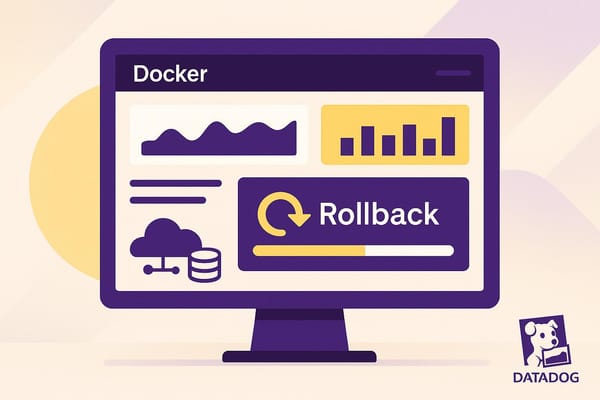Log Search Syntax Basics
Learn how to effectively use log search syntax for troubleshooting, performance monitoring, and security enhancement with practical examples.

Want to troubleshoot faster, monitor performance, and improve security? Datadog's log search makes it simple to sift through massive logs and find exactly what you need. Here's what you'll learn:
- Why Log Search Matters: Reduce troubleshooting time, track performance, boost security, and manage costs.
- How It Works: Use simple queries with attributes like
@status,@service, and operators likeAND,OR, andNOT. - Key Features: Build precise searches, set up filters, and group results for better insights.
- Practical Examples: Monitor payment issues, track login errors, and identify performance bottlenecks.
Mastering these basics helps teams resolve issues quickly - even without a large IT staff. Let’s dive into the details!
L03 Master Datadog Logs: Search, Filter & Analyze Like a Pro ...
Basic Log Search Components
Let's take a closer look at how Datadog's log search features work.
Building a Log Query
A Datadog log query is built using three main parts:
- Search terms: Words or phrases to match.
- Field names: Attributes of the log, like
@serviceor@status. - Operators: Symbols or keywords that define the logic of your query.
For example, if you want to find error messages from your checkout service, your query might look like this:
@service:checkout-api @status:error
Now let’s break down the operators that help refine these queries.
Main Search Operators
Datadog offers a variety of operators to make your queries more precise:
| Operator | Purpose | Example |
|---|---|---|
: |
Matches exactly | @host:web-server-01 |
AND |
Both conditions must match | @status:error AND @service:api |
OR |
At least one condition matches | @env:prod OR @env:staging |
NOT |
Excludes matches | NOT @status:success |
* |
Matches patterns or wildcards | @service:auth* |
These operators allow you to fine-tune your search for specific logs.
Searching by Log Attributes
Datadog logs come with several key attributes that you can use to filter your searches:
- @status: Indicates the log level or status, such as errors or warnings.
- @service: The service that generated the log, like
checkout-api. - @host: The server or container where the log originated.
- @timestamp: The time the log was created.
- @message: The actual content of the log.
By combining these attributes, you can zero in on the exact data you need. For example, to investigate an API outage that occurred recently:
@service:payment-api @status:error @timestamp:[now-1h TO now]
This query will pull up error logs from the payment API within the last hour. To dig even deeper, you can add more filters:
@service:payment-api @status:error @message:"timeout" @host:us-east*
Pro tip: Start with a broad query and gradually add filters to narrow your results. This way, you avoid excluding important logs by mistake.
Keep in mind that attribute names are case-sensitive and must include the @ symbol. Using incorrect names or missing the @ symbol is a common reason for empty search results.
Using Log Search in Daily Tasks
Mastering the basics of queries is just the start - filters can help you zero in on the data you need for daily log analysis.
Setting Up Log Filters
Saved filters make it easy to catch issues right away. For example:
@service:* @status:error @message:"payment failed"
If you need real-time updates, try auto-refreshing persistent filters:
@service:auth-service (@status:error OR @status:warn) @timestamp:[now-15m TO now]
Quick tip: Pin your most-used filters so they’re always within reach.
Organizing Search Results
Streamline your troubleshooting by organizing search results effectively:
| Method | Query Example | Why Use It? |
|---|---|---|
| Time-based grouping | @timestamp:[now-1h TO now] @service:checkout |
Monitor activity over a specific period |
| Service clustering | @service:* group by @service |
Group logs by service for clarity |
| Status aggregation | @status:* group by @status |
Summarize logs by status type |
To make patterns stand out, use grouping and detection techniques:
@service:api-gateway pattern:"timeout" group by @http.path
This approach highlights recurring issues, helping you spot trends faster.
SMB Search Examples
Here are some practical search patterns tailored for common business needs:
Payment Processing Monitoring
Track failed payments or transaction delays with this query:
@service:payment-service @status:(error OR timeout) @message:"transaction"
User Authentication Tracking
Identify login errors and session issues:
@service:auth @status:error @message:("invalid token" OR "expired session")
Performance Bottlenecks
Find services slowing down by checking response times over 500ms:
@service:* @duration:>500 group by @service
For more complex monitoring, combine attributes to pinpoint critical issues:
(@service:database OR @service:cache) @status:error @environment:production
Document your most effective search patterns so your team can respond faster when incidents occur.
Fixing Search Problems
Creating effective queries can sometimes be tricky. It's important to carefully compare your query against Datadog's guidelines to spot any potential issues.
Common Search Mistakes
One of the most frequent problems is syntax errors in queries. Here are some steps to help you troubleshoot and fix these issues.
Finding Query Errors
If your search results aren't what you expected, follow these steps to pinpoint the problem:
-
Check Attribute Names
Make sure the attribute names in your query match the ones in your log configuration. -
Validate Operators
Ensure you're using operators like AND, OR, and NOT in uppercase. These need to be formatted correctly to work. -
Review Time Ranges
Verify that the time range in your query includes the period for which you're trying to retrieve log data.
To identify errors, break down your query into smaller parts. For example:
# Start with a basic filter
@service:payment-service
# Add a condition for error status
@service:payment-service @status:error
# Finally, include a message criterion
@service:payment-service @status:error @message:"transaction timeout"
Tips for New Users
If you're new to constructing queries, start simple and build step by step. Here are some helpful tips:
- Begin with a basic query and add conditions gradually, testing each step to ensure accuracy.
- Use proper formatting:
- Write Boolean operators like AND, OR, and NOT in uppercase.
- Put multi-word phrases in quotes (e.g.,
"transaction timeout"). - Keep your query terms spaced clearly to avoid confusion.
Next Steps
Summary
Learn how to effectively use log search syntax for troubleshooting and system monitoring. Build queries incrementally: start with basic filters and gradually include more specific conditions.
Key tips to keep in mind:
- Use uppercase Boolean operators like AND, OR, and NOT.
- Wrap multi-word phrases in quotes.
- Remember that attribute names are case-sensitive.
Dive deeper with targeted learning resources to enhance your skills.
Learning Materials
Datadog offers a range of resources to help you refine your log search expertise, no matter your experience level.
-
Start with the Basics
Focus on essential skills like query syntax, advanced filtering, pattern detection, and setting up custom parsing rules. -
Hands-On Practice
Set up a test environment to:- Build and refine complex queries without impacting production.
- Experiment with different operators and attribute combinations.
- Check and validate your search results.
-
Explore Advanced Tools
Take your skills further by learning about Log Analytics, Custom Facets, Metric Generation, and Live Tail features.
FAQs
How can I start troubleshooting effectively using Datadog's log search syntax as a beginner?
To troubleshoot effectively with Datadog's log search syntax, start by familiarizing yourself with its key operators and structure. Use operators like AND, OR, and NOT to refine your searches, and leverage filters such as @timestamp or @status to narrow down results to specific timeframes or log levels.
For beginners, it’s helpful to start with simple queries and gradually incorporate more advanced filters. For example, searching for @status:error AND @service:payment will display all error logs related to the payment service. As you gain confidence, explore grouping logs by attributes or using facets to identify patterns.
Remember, practice is key. Experiment with different queries to understand how the syntax works and how you can tailor it to your specific needs.
What are some common pitfalls to avoid when creating log search queries in Datadog?
When building log search queries in Datadog, it's important to avoid certain common mistakes to ensure accurate and efficient results. Here are a few tips:
- Overusing broad search terms: Using overly generic terms can return too many results, making it harder to find relevant data. Be as specific as possible with your query.
- Ignoring proper syntax: Datadog's search syntax relies on specific operators (like
AND,OR,NOT, etc.) and structure. Make sure to follow the correct format to avoid errors. - Neglecting filters: Forgetting to use filters, such as time ranges or specific attributes, can result in unnecessary data clutter and slower query performance.
By paying attention to these details, you can create more efficient and meaningful log search queries, saving time and improving your analysis workflow.
How can I use Datadog's log search to track and enhance my service performance?
Datadog's log search syntax allows you to efficiently filter, analyze, and monitor logs to gain insights into your services' performance. By using key operators like status:error or service:your_service_name, you can pinpoint issues, track trends, and identify opportunities for optimization.
For example, you can search for all error logs from a specific service with:
service:your_service_name status:error
To monitor performance, combine filters, such as date ranges (e.g., @timestamp) or specific log attributes, to narrow down your results. This enables you to proactively address issues and improve overall system reliability.




